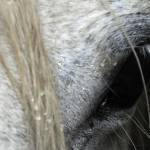Blindfold May Aid Neurologic Exams for Horses

Try this balance test: choose a spot where you won’t get hurt if you fall. Cross your arms across your chest and raise one foot off the floor. You might wobble a bit, but it’s not terribly hard to keep your balance. Now close your eyes and see what a difference that makes. Chances are, you’ll start to wobble more and more until you either put your foot down or fall over.
In horses, as in humans, sight is important in maintaining balance. A properly functioning brain uses subtle visual cues to indicate that the body is moving out of a stable position. Take away vision, and the brain can’t detect the imbalance quickly enough to make rapid corrections. The same is true of a brain that is impaired by injury or disease.
Theorizing that blindfolding a horse might help to differentiate between lame horses and those with neurologic problems, Dr. Hilary Clayton of Michigan State University led a study to determine the effect of blindfolding horses that were neither lame nor neurologically impaired. Researchers stood 20 blindfolded horses on a force plate for one minute, then measured and graphed the amount of sway for each horse. As expected, the horses showed increased motion, especially from side to side, when blindfolded.
Though this finding has not yet been evaluated as a diagnostic aid, it might eventually prove helpful in determining whether a particular horse is lame or has neurological problems related to West Nile virus, equine protozoal myeloencephalitis, or another condition. Movement defects might be similar in these horses, but observing the effects of blindfolding could highlight important differences.
Anyone handling a horse with suspected lameness or neurologic problems should be extremely careful because these horses can lose their balance and fall without warning. A veterinarian should be asked to examine any horse that shows lameness or neurologic signs. Handlers should avoid putting themselves between the horse and a fence or stall wall, and should not approach or lead the horse until another person is present to help.








